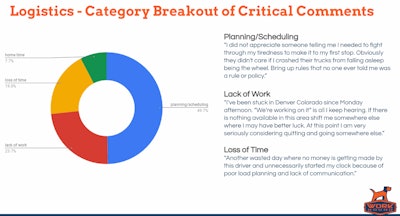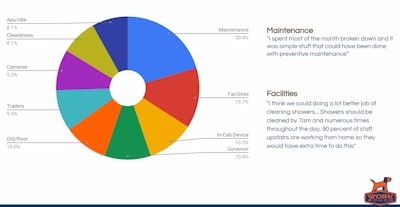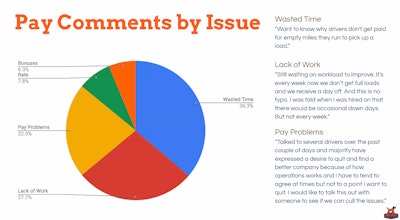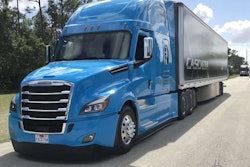 Planning and scheduling made up nearly half of all critical logistics-focused comments on the WorkHound driver retention platform in 2020. Some comments from drivers illustrate their frustrations. Logistics comments were the most-received last year.
Planning and scheduling made up nearly half of all critical logistics-focused comments on the WorkHound driver retention platform in 2020. Some comments from drivers illustrate their frustrations. Logistics comments were the most-received last year.
WorkHound CEO and co-founder Max Farrell on Thursday hosted a webinar detailing the top trends in driver priorities in 2020 based on feedback from more than 12,000 drivers from 61 trucking companies throughout the year.
 Max Farrell, WorkHound CEO and co-founder
Max Farrell, WorkHound CEO and co-founder
“Logistics comments include feedback related to operations, load planning, delays and challenges with routes,” Farrell said. “While this theme covers a broad range of topics, oftentimes these concerns are urgent, and they can cause drivers to seek employment outside of the industry.”
Trends in logistics feedback showed that drivers often felt deceived or set up to fail by their employer due to a lack of communication and transparency. The feedback showed that drivers also felt like they had been lied to by recruiters, dispatchers or planners, which breaks trust with the company.
Based on the feedback, WorkHound and Farrell recommend fleets improve transparency by “keeping drivers in the loop when making changes that would affect planning, scheduling, load specifics or even the expected length of the workday,” Farrell said. “Drivers feel they’re being intentionally deceived or set up for failure when they are unable to meet the expectations of the company or when they feel like the staff has lied to them. Make sure your support staff, including the recruiters, have set realistic expectations when speaking with potential and current drivers.”
Other logistical concerns raised by drivers included lack of work compared to their expectations, loss of time due to downtime and layovers, and home time.
The second-most common theme of drivers’ comments was equipment, which included maintenance, facilities, in-cab devices and more.
“When drivers have feedback to share about equipment, it tends to be urgent and likely, something is broken, or drivers haven’t been properly trained regarding how it works,” Farrell said.
Of all comments regarding equipment, 20% of them were about maintenance, and often about a shop not fixing an issue or requiring multiple trips to a shop about the same issue. Farrell said drivers also shared concerns about timeliness of repairs and understaffed shops, which correlated with concerns about drivers not being paid for work that isn’t driving. “Downtime equals a down paycheck,” he added.
 Maintenance and facilities were the top equipment-focused issues from drivers last year. Equipment comments were the second-highest submitted to WorkHound in 2020.
Maintenance and facilities were the top equipment-focused issues from drivers last year. Equipment comments were the second-highest submitted to WorkHound in 2020.
Not all feedback from drivers was negative, however. Overall, the percentage of total comments were fairly evenly split, with about a third being positive, a third being negative and a third being neutral.
One theme drivers commented on that was more positive than negative was people. People was also the third-most frequently mentioned theme. Comments about people were 38% positive and 35% negative, according to WorkHound’s data. Many comments within the theme, Farrell said, were to shout-out others in a positive way. Negative comments about people were likely to stem from interpersonal or departmental conflict, he said.
The vast majority of people-theme comments were evenly distributed between interactions with management, support staff and other drivers. The least amount of positive comments about people dealt with customers, Farrell noted.
“It’s clear from the driver comments that miscommunication, long waits and poor expectation setting were the focus of their dissatisfaction with customers,” he said.
 Pay was the focus of the fourth-highest amount of comments submitted by drivers in 2020. Their top concerns were about wasted time and lack of work, which resulted in less pay due to fewer miles.
Pay was the focus of the fourth-highest amount of comments submitted by drivers in 2020. Their top concerns were about wasted time and lack of work, which resulted in less pay due to fewer miles.
The biggest issues with pay, though, according to driver feedback, were wasted time (36% of comments) and lack of work (27%), both of which went back to downtime leading to less pay. Many of the problems drivers had with workload stemmed from the COVID-19 pandemic, Farrell added.
“We know being a driver requires more than just turning miles,” Farrell said. “Unfortunately, a lot of these activities aren’t compensated. Spending a high percentage of their time on uncompensated activities was the top concern for drivers talking about pay.”
For addressing issues with pay, WorkHound suggests looking for ways to simplify and stabilize pay structures to build trust with drivers and minimize confusion. Additionally, set realistic pay expectations to create certainty for drivers. Also, ensure the pay is aligned with market rates to signal respect and appreciation for drivers.













